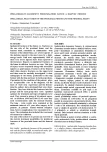Rupture of the diaphragm – diagnostic pitfalls and methods of treatment
Authors:
M. Carda; J. Šiller; K. Havlíček; D. Kusý
Authors‘ workplace:
The Institute of Medical Studies, The University of Pardubice
; Ústav zdravotnických studií, Univerzita Pardubice
; Traumacentre, The Surgical Dpt. of the General Hospital in Pardubice
; Traumatologické centrum, Chirurgická klinika KN Pardubice
Published in:
Úraz chir. 13., 2005, č.3
Overview
The authors present outcomes of a study of their own collection of 18 patients with rupture of the diaphragm. Blunt injuries predominate in accord with the literature (94 %), in the overhelming majority of cases cause by traffic accidents (78 %). The left side of diaphragm was injured in 78 %, the right in 22 %. Diaphragm injuries was diagnosed late in four cases. One patient failed to seek medical attention immediately after the injury because of minor symptomatology, once diaphragm injury was not detected during urgent surgery and twice it was not picked up on primary Xray or CT. We can anticipate diaphragm rupture primarily in cases of injury to the left side of the torso in high energy traumas. Typically diaphragm rupture occurs in conjunction with rib fracture, injury to the spleen, left kidney, urinary bladder, pelvic fracture and fracture of the left humerus. Unidentified diaphragm rupture may lead to the risk of injury to prolapsing viscera by not properly indicated thoracic drain, strangulation of the prolapsing viscera and to compression of the intrathoracic organs. The standard treatment consists in laparotomy and suture of the diaphragm, which was used twelve times (67 %) by the authors. Thoracotomy is the prefered method for right sided and old ruptures. The diaphragmplasty using unresorbable mesh is reserved for old ruptures with defects (in this study used twice).
Key words:
diaphragm rupture, diagnostic, treatment.
Sources
1. CRUZ, C., J., Minagi H. Largebowel obstruction resulting from traumatic diaphragmatic hernia: Imaging findings in four cases. Am J Roentgen. 162, 1994, 4, 843–845.
2. DOMENE, C. E., VOLPE, P., SANTO, M. A. et al. Laparoscopic treatment of traumatic diaphragmatic hernia. J Laparoendosc Adv Surg Tech. 8, 1998, 4, 225–229.
3. DUNSIRE, M. F., FIELD, J., VALENTINE, S. Delayed diagnosis of cardiac tamponade following isolated blunt abdominal trauma. Br J Anaesth. 87, 2001, 2, 309–313.
4. CHMÁTAL, P., NOVOTNÝ, M., KUPKA, P. et al. Tenzní gastrotorax jako pozdní následek nediagnostikované ruptury bránice. Rozhl Chir. 84, 2005, 1, 3–6.
5. KLEIN, J., KRÁL, V., KOJECKÝ, Z. et al. Úskalí diagnostiky traumatické ruptury bránice. Úraz chir. 7, 1999, 4, 6–10.
6. KLEMM, G., MEISSNER, A., BOESE LANDGRAF, J. Intrathoracic hemorrhage of the intraabdominal organs following diaphragmatic rupture. A rare cause of hemothorax. Aktuelle Traumatol. 1989, 19, 212–214.
7. LUKÁČ, L., PLEVA, L. Poranění bránice – diagnostika a léčba. Úraz chir. 7, 1999, 4, 11–17.
8. MAY, A., K., MOORE, M., M. Diagnosis of blunt rupture of the right hemidiaphragm by technetium scan. Am Surg. 65, 1999, 8, 761.
9. MILLER, L., BENNETT, E., V., ROOT, H. D. et al. Management of penetrating and blunt diaphragmatic injury. J Trauma. 24, 1984, 5, 403.
10. MOORE, E. E., MALANGONI, M. A., COGBILL, T. H., et al. Organ injury scaling. IV: Thoracic vascular, lung, cardiac, and diaphragm. J Trauma. 36, 1994, 3, 299–300.
11. SABER, W. L., MOORER, E. E., HOPEMAN, A. R. et al. Delayed presentation of traumatic diaphragmatic hernia. J Emerg Med. 4, 1986, 1, 1.
12. STEINAU, G., BOSMAN, D., DREUW, B. et al. Zwerchfellverletzungen – Klassifikation, Diagnostik und Therapie. Chirurg. 68, 1997, 5, 509–512.
13. STRAŠLIPKA, J., LUDVÍK, P. Traumatická ruptura bránice–kazuistika. Rozhl Chir. 81, 2002, 3, 121–122.
14. TRENTZ, O. Tscherne Unfallchirurgie – Kopf und Körperhöhlen. SpringerVerlag: Berlin Heidelberg, 2000. 378 s.
15. VYHNÁNEK, F., FANTA, J., VACH, B. et al. Traumatická ruptura bránice u tupého poranění. Rozhl Chir. 81, 2002, 5, 230–235.
Labels
Surgery Traumatology Trauma surgeryArticle was published in
Trauma Surgery

2005 Issue 3
- Metamizole vs. Tramadol in Postoperative Analgesia
- Metamizole at a Glance and in Practice – Effective Non-Opioid Analgesic for All Ages
- Current Insights into the Antispasmodic and Analgesic Effects of Metamizole on the Gastrointestinal Tract
- Spasmolytic Effect of Metamizole
- Obstacle Called Vasospasm: Which Solution Is Most Effective in Microsurgery and How to Pharmacologically Assist It?
Most read in this issue
- Rupture of the diaphragm – diagnostic pitfalls and methods of treatment
- Ipsilateral fractures of the proximal femur and the femoral shaft
